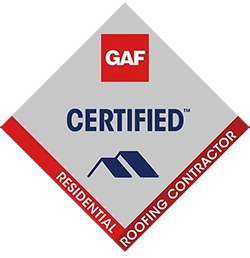Signs You May Need Gutter Guards
Gutter guards aren't required for all homes, but the signs of clogged and overflowing gutters are clear. Indicators of chronic gutter troubles are:
- Soggy ground or visible erosion patterns around your home's foundation
- Leaky joints or seams where water leaks out of gutters
- Mold growth, peeling exterior paint, or interior water stains on walls near gutters.
- Frequent clogs that lead to overflow and water spilling over gutters
- Visibly damaged, sagging, or misaligned gutters that no longer correctly direct rainwater
How To Choose a Gutter Guard Installer
Assess Their Experience
Look for an experienced gutter guard installation company that has been in business for many years and has installed various guard brands and models. These companies know how to properly measure and handle the installation of gutter guards on your unique home setup. Inquire how long they’ve been installing guards and request local referrals.
Verify Proper Licensing and Insurance
Verify that any providers you're considering are properly certified, bonded, and insured, holding both general liability and workers compensation protection. This shields you from liability for possible injuries and accidents. Request current licensing and insurance papers from any potential providers.
Choose Reputable Brands
Look for leading gutter guard brands such as Gutter Helmet and LeafFilter when selecting an installer. Avoid generic no-name or off-brand guards, which likely have not gone through rigorous quality control testing.
Seek Custom Fit Services
For superior performance, gutter guards need custom measurements and trimming on-site to match your gutters. Pick a company that takes specific measurements and trims guards for your home instead of using universal options. Correctly-fitted guards prevent debris-trapping gaps from forming.
Examine Warranties
High-quality gutter guard installers normally offer 20-year or lifetime warranties covering clogs, leaks, rust, and other problems. Before selecting a company, carefully review the warranty terms for workmanship and materials guarantees. Warranties are an excellent means of protecting your gutter investment.
Check Reviews and Referrals
Be sure to check online reviews on sites such as Yelp, Google Reviews, or the Better Business Bureau (BBB) to learn more about customer experiences. You can also ask your neighbors for recommendations on quality gutter guard businesses in your area. When researching potential providers, you should choose companies with a history of consistent positive feedback rather than just one or two reviews.
Types of Gutter Guards
The six most common types of gutter guards include the following:
- Foam guards are light and easy to install. With this type of guard, debris lands on the foam instead of in your gutter. On average, you can expect to spend $2.45 per linear foot for foam guards.
- Brush guards are made of large brush bristles that are installed in your gutters, stopping debris while allowing water to pass through. Brush guards cost roughly $4.03 per linear foot.
- Screen guards have large holes that let water through while blocking debris. Screen guards cost roughly $4.13 per linear foot.
- Mesh guards stop debris but allow water to flow through. Mesh guards have even smaller holes than screen guards. They're durable and allow debris to slide off rather than sitting on top of your gutters. Mesh guards cost around $3.93 per linear foot.
- Micro-mesh guards have even smaller holes than mesh guards, allowing even less debris through than mesh. They are very effective. On average, you can expect to pay $5.02 per linear foot for micro-mesh guards.
- Surface tension guards, sometimes called reverse curve guards, use surface tension to let debris slide off while water flows into the gutter. They can typically be seen from the ground. On average, you can expect to pay $3.05 per linear foot for surface tension guards.













